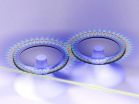In between red light and blue light
Leipzig researchers discover new functionality of molecular light switches
2014-10-20
(Press-News.org) This news release is available in German.
Diatoms play an important role in water quality and in the global climate. They generate about one fourth of the oxygen in the Earth's atmosphere and perform around one-quarter of the global CO2 assimilation, i.e. they convert carbon dioxide into organic substances. Their light receptors are a crucial factor in this process. Researchers at the Leipzig University and the Helmholtz Centre for Environmental Research have now discovered that blue and red light sensing photoreceptors control the carbon flow in these algae. These results have been recently published by the scientists in the well-known online trade journal, PLOS ONE.
"Diatoms display a special way of reacting to light and adapting their metabolism to the changing light conditions in the water", says Prof. Dr. Christian Wilhelm, Head of the Plant Physiology Department at the Leipzig University. "For the first time, we have been able to show that the light receptors, which measure the intensity of the blue or red light, not only change the genetic transcription, but also directly control the activity of enzymes in the metabolism."
A rapid light change from blue light to red light and vice versa does not influence the photosynthesis output, but the metabolism is drastically reversed within 15 minutes. "This way, cells that have grown in red light, which continue to be cultivated in a blue light environment can still perform photosynthesis, but can no longer grow."
These "light switches" can be used to control the carbon flow in cells. The evidence for this was provided using the MetaPro metabolomic platform established at the Helmholtz Centre for Environmental Research. "This opens up new ways for the biotechnological control of cells", explains Christian Wilhelm.
"This work is further evidence of the added-value of intensive cooperations between non-university and university institutions, particularly with the Faculty of Biosciences, Pharmacy and Psychology", Prof. Martin von Bergen, Spokesman of the Department of Metabolomics at the UFZ and one of the co-authors, is pleased to say.
The Leipzig-based algae experts in plant physiology at the Leipzig University already drew attention to itself two years ago with another publication: Together with scientists from Karlsruhe and Bremen, they provided evidence that sunlight can be converted into pure natural gas in a highly efficient manner with the aid of microorganisms. In doing so, the metabolism of green algae is reversed.
INFORMATION:
The publication about the diatoms:
Jungandreas A, Schellenberger Costa B, Jakob T, von Bergen M, Baumann S, et al. (2014) The Acclimation of Phaeodactylum tricornutum to Blue and Red Light Does Not Influence the Photosynthetic Light Reaction but Strongly Disturbs the Carbon Allocation Pattern. PLOS ONE 9(8): e99727. doi:10.1371/journal.pone.0099727
The publication about the green algae:
Methane production from glycolate excreting algae as a new concept in the production of biofuels
DOI: 10.1016/j.biortech.2012.06.120
Contacts:
Prof. Dr. Christian Wilhelm
Institute for Biology, Plant Physiology / Leipzig University
Tel: ++49-341-97-36874
E-mail: cwilhelm@rz.uni-leipzig.de
Internet: http://www.uni-leipzig.de/~pflaphys/
and
Prof. Dr. Martin von Bergen, Dr. Sven Baumann
Department of Metabolomics at the Helmholtz Centre for Environmental Research (UFZ)
Tel.: ++49-341-235-1211, -1099
http://www.ufz.de/index.php?de=17634
http://www.ufz.de/index.php?de=17634
or via
Tilo Arnhold, Susanne Hufe (UFZ press office)
Tel: ++49-341-235-1635, -1630
http://www.ufz.de/index.php?de=640
ELSE PRESS RELEASES FROM THIS DATE:
2014-10-20
WASHINGTON, DC – A mass of marine debris discovered in a giant sinkhole in the Hawaiian islands provides evidence that at least one mammoth tsunami, larger than any in Hawaii's recorded history, has struck the islands, and that a similar disaster could happen again, new research finds. Scientists are reporting that a wall of water up to nine meters (30 feet) high surged onto Hawaiian shores about 500 years ago. A 9.0-magnitude earthquake off the coast of the Aleutian Islands triggered the mighty wave, which left behind up to nine shipping containers worth of ocean ...
2014-10-20
Since World War II, more than 45 international human-rights treaties have been signed by many of the world's roughly 200 countries. But why do some states sign such accords, especially if they lack a strong human-rights commitment in the first place?
One prominent idea holds that treaty-ratifying countries are essentially bought off: They agree to lend support to the human-rights movement in exchange for material good, such as foreign aid or more trade. However, a new study co-authored by an MIT political scientist finds that not to be the case; the actions of states, ...
2014-10-20
This news release is available in German. What started out as a mathematical oddity, has now become a new kind of laser technology. Two years ago, physicists at TU Wien predicted a paradoxical laser effect: Under certain conditions, a laser can be switched on not by supplying it with more energy, but by taking energy away from the laser. First experimental signatures of this effect were recently reported at TU Wien. In collaboration with colleagues at Washington University in St. Louis, USA and at Riken, Japan the researchers have now succeeded in transferring the paradoxical ...
2014-10-20
Amsterdam, NL, October 20, 2014 – White Canes provide low-tech assistance to the visually impaired, but some blind people object to their use because they are cumbersome, fail to detect elevated obstacles, or require long training periods to master. Electronic travel aids (ETAs) have the potential to improve navigation for the blind, but early versions had disadvantages that limited widespread adoption. A new ETA, the "EyeCane," developed by a team of researchers at The Hebrew University of Jerusalem, expands the world of its users, allowing them to better estimate ...
2014-10-20
Climate change predictions for the Middle East, like other arid regions of the world, are alarming. In an area known for its water scarcity, rainfall is expected to decrease even further in the near future, spelling disaster for the functioning of unique ecosystems — hotspots of biodiversity and rich genetic fodder for essential crops.
To test these dire predictions, Prof. Marcelo Sternberg of the Department of Molecular Biology and Ecology of Plants at Tel Aviv University's Faculty of Life Sciences, together with ecologists from the University of Tübingen ...
2014-10-20
Older people from Pakistani and Bangladeshi communities in England fear changes in cultural attitudes will leave them without the family care they expect to rely on in their twilight years, a new study has found.
The research, undertaken at Brunel University London, reports that elderly people in these communities expect their children and wider family will look after them in old age and are traditionally unlikely to take-up state social services.
However, those surveyed also expressed uncertainty over whether changes in cultural attitudes and geographical factors ...
2014-10-20
Members of today's younger Net Generation aren't more tech savvy than their teachers just because they were born into a world full of computers. In fact, if it weren't for the coaxing and support of their educators, many students would never use their electronic devices for more than playing games or listening to music. So says Shiang-Kwei Wang of the New York Institute of Technology in the US, who led a study on how middle school science teachers and their students use technology inside and outside the classroom. The findings¹ appear in the journal Educational Technology ...
2014-10-20
ANN ARBOR—In a design that mimics a hard-to-duplicate texture of starfish shells, University of Michigan engineers have made rounded crystals that have no facets.
"We call them nanolobes. They look like little hot air balloons that are rising from the surface," said Olga Shalev, a doctoral student in materials science and engineering who worked on the project.
Both the nanolobes' shape and the way they're made have promising applications, the researchers say. The geometry could potentially be useful to guide light in advanced LEDs, solar cells and nonreflective ...
2014-10-20
Researchers at Griffith University's Institute for Glycomics have moved a step closer to identifying a treatment for the dreaded Human parainfluenza virus (hPIV).
These highly-infectious viruses are the leading cause of upper and lower respiratory tract disease in young children, including Croup, responsible for thousands of hospitalisations in the developed world, and hundreds of thousands of deaths each year in developing countries.
Institute Director Professor Mark von Itzstein said his Group's research findings published in the prestigious journal Nature Communications ...
2014-10-20
CHICAGO --- During the 2012-2013 school year, 38 Chicago Public School (CPS) students and staff were given emergency medication for potentially life-threatening allergic reactions. This finding is detailed in a new Northwestern Medicine® report in partnership with CPS.
Following national and local legislation, CPS was the first large, urban school district in the nation to develop and implement an initiative to supply all public and charter schools in Chicago with epinephrine auto-injectors (EAIs) -- medical devices used to treat acute allergic reactions.
The impact ...
LAST 30 PRESS RELEASES:
[Press-News.org] In between red light and blue light
Leipzig researchers discover new functionality of molecular light switches


